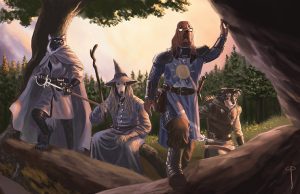
In the past in “Claws and Effect” I’ve talked about how humor works in the game and ideas for long-term play. Plus, both Pugmire and Monarchies of Mau offer advice on how to “hack” a game into a different shape. But I thought this time I’d pull all that together and show you what effect each of those adjustments can have on the style of chronicle you want to run.
Silly
Yes, Pugmire starts off as light-hearted, but you can amp things up to be explicitly silly.
No Death: The Yosha sidebar on p. 97 of Pugmire talks about ditching saving throws and never letting a character actually die. I would definitely use this for a silly game. However, one wrinkle is that you’d have to give shepherds another basic spell, since “Spare the Dying” would be useless. (I’d probably switch it to a simple “give a character 1 stamina point” spell.)
Faster Pace: In my experience, players work their way past the gags and jokes about 1 to 2 hours in. So cut the session down to that length. I’d also award levels quickly — perhaps after every story.
Funny Fortune: A new rule is that players will always get a Fortune if the entire table breaks out in laughter at a joke (or groan audibly at a terrible pun). This will encourage players to keep the punchlines rolling.
Gritty
On the other hand, you can go the other direction and make things a bit darker and grittier. The original pitch for the game was called “Fall of Pugmire,” and you can bring back that Gothic, elegiac feel if you want.
No Rucksack Save: Lose the Wisdom save to see if characters pack something in their rucksack. Characters have only what they have, which means that every item counts. (Merchants are an exception — I’d have them lose their advantage, but they would still get to make such rolls, making them VERY useful in a gritty game.)
Heavier Enemies: The enemies in the book are skewed to be a touch on the harder side, but nothing a group of characters can’t defeat if they work together. Using monsters that are 1-2 CR higher than normal, however, can really give characters a tough fight. They’ll have to use every resource available.
Political Animals: Monarchies of Mau already has a strong political background, and Pugmire has one too, although it’s more muted. Amp both of those up, making the characters the focus of a number of intrigues. Muddy the waters between “good” and “bad” dogs. Push the Monarchies closer to all-out war between the city-states. Everything can fall apart with a hasty word or a errant punch.
Epic
Epic doesn’t just mean long-term play (although there’s some overlap in the two concepts). It’s also bigger-than-life storytelling, where everything feels like a legend in the making.
Starting Artifacts: Give each player an artifact they can improve, right out of the gate. Attach a story to each: “This is my mother’s battleaxe” or “I stole this cloak from the Monarch’s castle the night she died.” Then, allow the character to improve the item every two levels, without spending an improvement. (This is a change from the normal Mau rules, but it really adds a feeling of escalating power.)
Minions and Legendary Enemies: The optional rules for minions and legendary characters in the Enemies chapter of each book is perfect for epic-style play. Mobs of creatures defending a powerful warlord or a conniving necromancer are exactly the kinds of characters players love to hate. Speaking of which…
Returning Enemies: Find ways to bring old enemies back. Maybe the characters keep running into Rondo Border-Collie, the Rat King, or Kibu the Red. Then add some more CR to them. Seeing old enemies come back more powerful that before definitely feels epic.

Could you expand and explain in details ‘No Rucksack Save’? I do not understand the concept here…
It’s covered in Pugmire, p. 90-91!